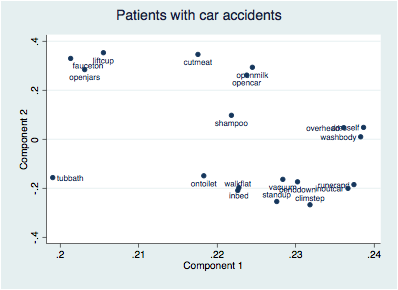Session Information
Session Type: ACR Poster Session A
Session Time: 9:00AM-11:00AM
Automobile driving is an important instrumental activity of daily living with heightened importance among arthritis sufferers who are disproportionately reliant on driving for the preservation of health, well-being, and quality of life. Despite its importance to patients, scant data exists regarding the impact of arthritis on driving performance. We investigated occurrences of motor vehicle accidents (MVA) in patients with RA and how clinical function measures may be associated with MVA.
Methods:
Using a large US observational cohort, the National Data Bank for Rheumatic Diseases (NDB), we compare RA and adult non-RA rheumatic disease patients who had a validated MVA. Within each group, we also compare patients with and without a MVA measured at a random observation before the accident or at any time for those without an accident. Patients with <2 questionnaires were excluded. MVAs were identified by validated hospitalizations (code 162) and by death codes (ICD9, E81*). We conducted a principal component analysis (PCA) using the 20 items from the HAQ. Scree plot and the Kaiser criterion were used to select the number of components.
Results:
From a total of 37,743 patients, we found 142 MVA, 103 recorded as hospitalizations and 39 as deaths. From the 26,905 RA adults, 90 (0.33%) had a MVA while the 10,838 non-RA patients had somewhat higher number of 52 (0.48%) (P=0.037). There was no statistical difference in demographic or clinical outcomes between those with or without a MVA in patients with RA, though there was an association with the number of individuals living the patient s household with those in MVA having fewer (p=0.02). Non-RA patients with MVA were older than patients with no accidents or compared to RA patients (Table). Scree plot analysis and Kaiser criterion identified the first two components as being the most associated with MVA (Figure). Component 1 (overall disability score) accounted for 56% of the variance in MVA risk while Component 2 (individual HAQ items) accounted for an additional 8% of variance. Of note, Component 2 included HAQ response items focused on upper extremity function / mobility (i.e. opening a car door, eating, opening a jar) and did not include items focused on lower extremity function (Figure).
Conclusion:
These findings provide evidence that reduced functional independence and hand mobility, outcomes associated with RA disease activity, may be linked to poor driving and/or future vehicle accidents.
Table –Comparison between RA and non-RA patients with and without car accidents
|
|
|
|
|
||||
|
Variables
|
RA patients (N=26,905)
|
Non-RA patients (N=10,838)
|
P-value for
|
||||
|
No car accidents
|
Car accidents
|
|
No car accidents
|
Car accidents
|
|
car accidents
|
|
|
mean (sd) or %
|
(N=26,815)
|
(N=90)
|
P
|
(N=10,786)
|
(N=52)
|
P
|
RA vs non-RA
|
|
Age (yrs)
|
60.81 (13.31) |
60.17 (13.25) |
0.65 |
60.88 (13.69) |
66.98 (15.21) |
0.00 |
0.01 |
|
Sex (% Male) |
0.21 (0.41) |
0.22 (0.42) |
0.72 |
0.15 (0.36) |
0.22 (0.42) |
0.22 |
0.93 |
|
Employed (%) |
0.34 (0.47) |
0.26 (0.44) |
0.12 |
0.34 (0.47) |
0.22 (0.42) |
0.08 |
0.59 |
|
Educational level (yrs)
|
13.67 (2.38) |
13.36 (2.47) |
0.21 |
14.10 (2.32) |
14.04 (2.50) |
0.86 |
0.12 |
|
Dependency |
1.23 (0.96) |
1.36 (0.94) |
0.42 |
1.17 (0.97) |
1.17 (1.07) |
0.22 |
0.22 |
|
None of the time (%) |
29.27 |
19.70 |
29.78 |
25.61 |
|||
|
A little of the time (%) |
41.46 |
36.36 |
33.14 |
35.51 |
|||
|
Some of the time (%) |
14.63 |
31.82 |
28.70 |
30.26 |
|||
|
Most of the time (%) |
12.20 |
12.12 |
7.33 |
7.33 |
|||
|
All of the time (%) |
2.44 |
0.00 |
1.05 |
1.29 |
|||
|
Number of person in household |
2.21 (1.05) |
1.97 (0.82) |
0.02 |
2.19 (1.07) |
1.97 (1.26) |
0.20 |
0.98 |
Figure 1- Component loadings of the first two PCAs.
To cite this abstract in AMA style:
Michaud K, Pedro S, Mikuls TR. Are RA Patients at a Higher Risk for Car Accidents? [abstract]. Arthritis Rheumatol. 2017; 69 (suppl 10). https://acrabstracts.org/abstract/are-ra-patients-at-a-higher-risk-for-car-accidents/. Accessed .« Back to 2017 ACR/ARHP Annual Meeting
ACR Meeting Abstracts - https://acrabstracts.org/abstract/are-ra-patients-at-a-higher-risk-for-car-accidents/

